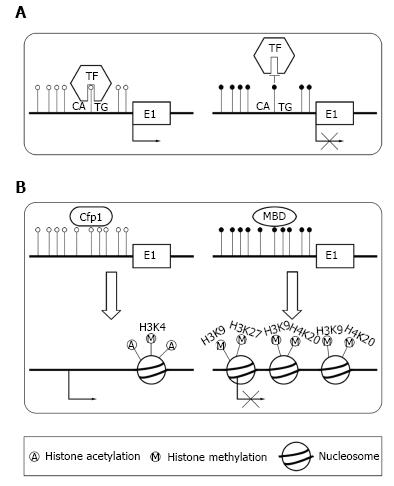Copyright
©2014 Baishideng Publishing Group Inc.
World J Clin Infect Dis. Nov 25, 2014; 4(4): 41-49
Published online Nov 25, 2014. doi: 10.5495/wjcid.v4.i4.41
Published online Nov 25, 2014. doi: 10.5495/wjcid.v4.i4.41
Figure 2 Transcriptional suppression mechanisms of DNA methylation in TSSs.
The normal conditions are presented in the left column and aberrant conditions are shown on the right. The black dots represent methylated CpG sites and the white circles represent unmethylated CpG sites. A: In normal cells, transcription factors (TF) bind to unmethylated binding site, allowing transcription. Aberrant methylated binding site prevent TF binding to its normal sites; B: In normal cells, unmethylated CpG island can recruit CpG binding proteins (Cfp1) and trigger histone modifications characterized by high levels of acetylation and trimethylated H3K4, H3K36 and H3K79. Finally, it forms a structure suitable for transcription. Aberrant methylated recruit methyl-CpG-binding domain (MBD) proteins and trigger histone modifications characterized by high levels of H3K9, H3K27 and H4K20 methylation and low levels of acetylation. It represses the transcriptional permissiveness of chromatins and results in gene silencing.
- Citation: Gao S, Wang K. DNA methylation in liver diseases. World J Clin Infect Dis 2014; 4(4): 41-49
- URL: https://www.wjgnet.com/2220-3176/full/v4/i4/41.htm
- DOI: https://dx.doi.org/10.5495/wjcid.v4.i4.41









